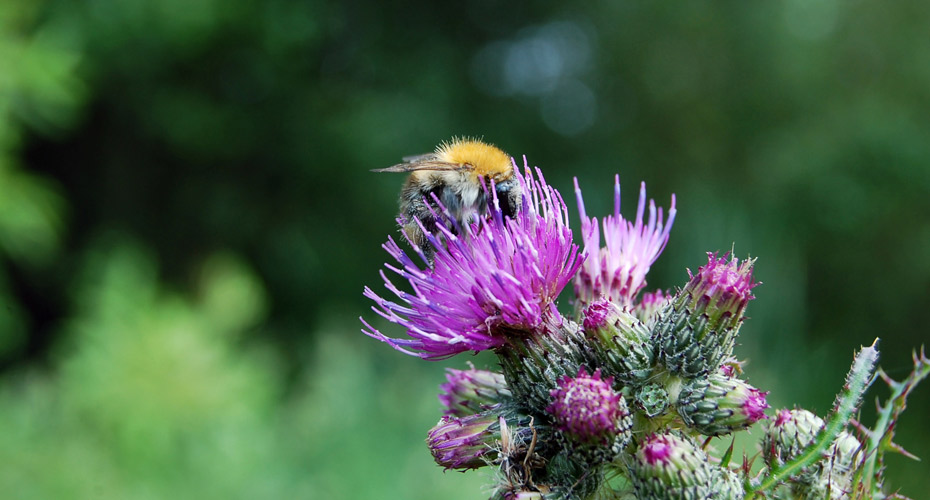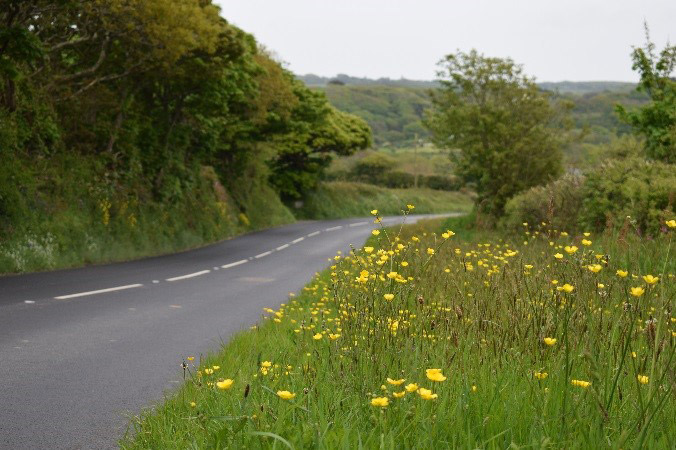
A bumblebee feeding in a road verge.

A flower-rich road verge: an important source of food for pollinators, near Culdrose. Photo by Ben Phillips.
Protecting pollinators in Cornwall using road verges and hedges
Protecting pollinators
Ben Phillips, Kevin Gaston, James Bullock and Juliet Osborne, Environment and Sustainability Institute.
Key findings:
- Road verges and hedges had a much greater abundance of flowers and flower species than field interiors.
- Road verges and hedges are really important for reversing the decline on pollinating insects.
- Pollinators tend to be in the centre of verges rather than at the edges, and there are fewer pollinators next to busy roads.
- Cutting grass verges in the summer reduces the number of pollinators and flowers
Summary
At last count, there were 7,430 kilometres of roads in Cornwall. Narrow lanes, tall hedges and stone-faced earth banks are deeply characteristic of the Cornish landscape, and most of us spend a good part of our days travelling on these roads. The remains of the animals that stare back at us from the asphalt – the victims of collisions with traffic – suggest that roads are inherently bad for wildlife. But the landscapes beyond our roads have also facilitated the decline of many species, not least pollinators (e.g. bees, but also flies, beetles and more). Specifically the loss of flower-rich habitats and the use of pesticides have made agricultural landscapes increasingly difficult places for pollinators to live. For example, 97% of wildflower meadows have been lost in the UK since the 1930s. Surprisingly then, the network of habitats that border our roads (‘road verges’) may provide an incredible opportunity to feed and home our dwindling pollinator populations.
Road verges as pollinator habitats
Road verges variably consist of grass, scrub, trees, and hedges. In rural areas, they provide refuges from cultivation and agrochemical application that can be hotspots for flowers and pollinators. But traffic might negatively affect pollinators in road verges, e.g. due to pollution and collisions. And current road verge management does not generally consider pollinator (or nature) conservation, but is dictated by safety, aesthetics and costs (primarily cutting in spring and summer to maintain visibility for road users). Our study set out to understand the role of road verges as habitats for pollinators, and the impacts of traffic and management.
We surveyed flowers and pollinators along transects in road verges, hedges and adjacent fields at 19 study sites in Cornwall, UK. These covered a wide range of verge sizes (5-23m wide), road types (unclassified roads to major roads), traffic densities (10-1,400 vehicles/h), and field types (various arable crops, pasture and agricultural meadows). Our results showed that road verges support considerably more flowers and pollinators than field interiors, which were consistently very poor for pollinators. This emphasises that vast areas of our agricultural landscapes provide very little for pollinators, making it vital to protect and enhance our road verges, hedges and other flower-rich habitats.
Managing our verges
But not all road verges are equal. Flower-rich verges had more pollinators, so clearly we should aim to increase the amount and diversity of flowers in road verges. However, we also found that verges along the busiest roads had, on average, half as many pollinators as verges along the quietest roads, and that there were fewer pollinators within 2m of roads compared to deeper into verges. This is probably due to pollution and disturbance from traffic.
We also found that cutting road verges in summer massively reduces the numbers of flowers and pollinators, even weeks later. Routine management in our study area is typical for the UK and involves cutting verges in summer, i.e. when pollinators are most active. Although this is primarily carried out to meet safety requirements, the extent of cutting often far exceeds this. Primarily, the inner strip of verges alongside the road often needs to be cut to maintain visibility for road users. Given that fewer pollinators are found within 2 m of roads, we can cut this inner strip regularly without compromising the rest of the verge, which is more important for pollinators.
Based on our findings, we propose two main recommendations for management:
- Do not cut road verges during peak flowering times (i.e. delay cutting until autumn), except where required for safety (i.e. visibility splays).
- Prioritise beneficial management for pollinators on wider road verges (at least 2m wide), roads with less traffic and areas away from the immediate vicinity of the road.
The Cornish context
The findings of our study support the ambitions of for Cornwall Council’s Pollinator Action Plan, Environmental Growth Strategy and Making Space for Nature project. In reality, managing our road verges for pollinators will require a fine balancing act between nature conservation, safety guidelines, management costs, existing contractual obligations, and public demand for tidiness. Yet it remains a major opportunity, especially because of the extent of the 7,430 kilometres of road in Cornwall: enhancing them for wildlife, even slightly, would provide significant collective benefits.
The Environment & Sustainability Institute (University of Exeter) is working in partnership with the Cornwall Area of Outstanding Natural Beauty (AONB) Unit to study road verges and hedges. The four year project is exploring their role in conserving nature and providing benefits to people, and investigating how to manage them in the best way possible. To find out more about the project, contact Ben at B.B.Phillips@exeter.ac.uk.
